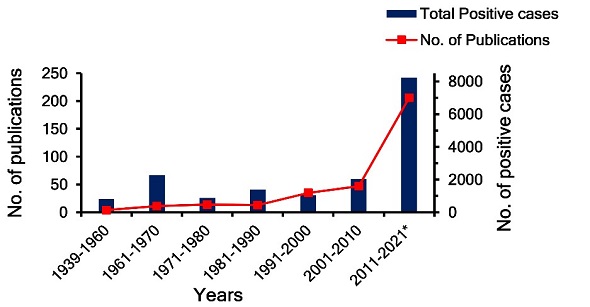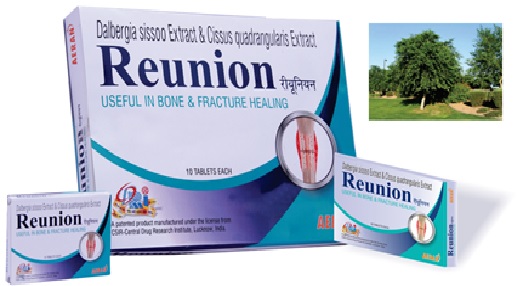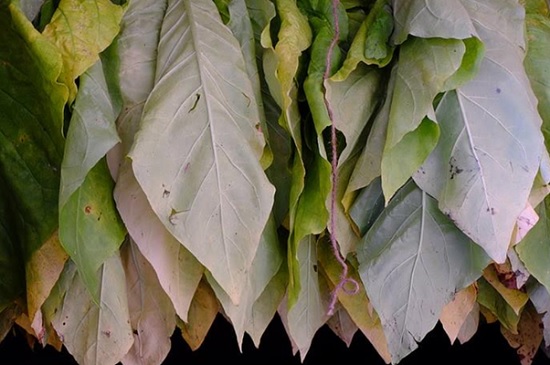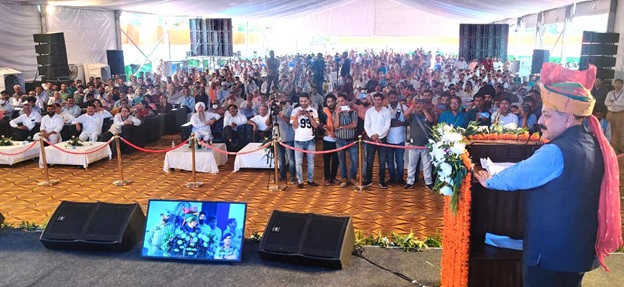
Decade-wise distribution of dermatophytosis cases from India. A list of publications pertaining to dermatophytosis (red line) and KOH positive cases (blue bar) in India is shown.
Dermatophytosis is a fungal skin caused by a group of fungi collectively termed dermatophytes. A group of researchers from the CSIR-Institute of Genomics and Integrative Biology (CSIR-IGIB), New Delhi; Dr. Babasaheb Ambedkar Medical College and Hospital; and University College of Medical Sciences-Guru Teg Bahadur (UCMS-GTB)Hospital, Delhi, have studied the available scientific literature of dermatophytosis in India over the last 80 years to understand its prevalence in different parts of the country.
Several recent reports highlight increasing incidences of terbinafine (a medicine to treat fungal skin infections) resistance among dermatophytes from several countries including India.
“Although hospital-based studies from different parts of the country are reported in literature, a comprehensive data analysis was not available thus far. An analysis of dermatophytosis in India from 1939-2021 is expected to help the medical and scientific community in better region-specific disease management towards a large number of observed terbinafine-resistance cases in India, especially as terbinafine is one of the primary drugs of choice to treat fungal skin infections,” researchers inform India Science Wire.
Although dermatophytes are found worldwide, the distribution of prevalent fungal pathogens varies with climatic, geographic, socioeconomic, and overall lifestyle conditions in the respective regions. These fungi, known as keratinophilic, grow on keratinous substances such as hair, hooves, nails, etc. They have filamentous structures, having a long, thin series of cells attached to one another or a very long, thin cylindrical single cell.
Dermatophytes have often exhibited a unique phenomenon of a significant shift in the prevalent dermatophyte spectrum over different periods. The researchers have mined the literature data of the last 80 years and presented the epidemiological situation and prevalent pathogens in India. A year-wise analysis of dermatophytosis cases during 1939-2021 across India showed a nearly four-fold increase in cases in the period 2011-2021 as compared to previous decades.
The researchers mined through over 1000 articles manually. They analysed relevant epidemiological data such as the geographical location of the patient or disease, number of reported cases, etiological agents, site of lesions on the host, age, gender, reporting year, annual prevalence, etc.

“The year-wise analysis also indicated that the distribution of prevalent dermatophytes is not constant and has varied over the years in India. In the initial period of analysis, i.e., 1939–1960, Trichophyton rubrum is the predominant fungal pathogen in more than 60% of all reported cases, followed by Epidermophyton spp. (33.3%). In 1971–80, Trichophyton violaceum was the predominant pathogen with 56.6% of all reported cases. Trichophyton rubrum continues to be the most commonly reported pathogen in the following decades, from 1981 to 2010”, researchers explain.
In 2011–2021, however, there was a dramatic shift in the dermatophyte spectrum, with infections by Trichophyton mentagrophytes/Trichophyton interdigitale complex (53.3% cases) outnumbering the infections by Trichophyton rubrum (26.4% cases) or any other dermatophytic fungi. This shift appears to be more recent, with more than 64% of all reported cases in 2016–2021 associated with these fungi.
However, post-2016, the researchers have noticed a concomitant increase of terbinafine resistance during treatment, which suggested an overall increase in dermatophytosis from India in the last decade, i.e., 2011-2021. It could be linked to recalcitrant, difficult-to-treat, and drug-resistant cases, despite the evidence of resistance appearing more recently.
Also, analysis of the drug-resistant and drug-sensitive strains using their whole genome data suggested that apart from mutations in the target gene, there is overall relatedness among the genomes of both resistant and sensitive strains.
The researchers mined through over 1000 articles manually. They analysed relevant epidemiological data such as the geographical location of the patient or disease, number of reported cases, etiological agents, site of lesions on the host, age, gender, reporting year, annual prevalence, etc.
The collaborative study was funded by the Department of Biotechnology (DBT), Govt. of India. The study has been published in Mycopathologia, an official journal of the International Union of Microbiological Societies (IUMS). The research team comprised Pawan Kumar, S. Ramachandran, Shukla Das, S.N. Bhattacharya and Bhupesh Taneja.
Since, no comprehensive data were available concerning dermatophytosis for the estimations of disease burden or overall assessment of prevalent fungal pathogens in India, This comprehensive literature mining and phylogenomics analysis of dermatophytosis would help the medical and scientific community in making informed decisions and better disease management, especially towards emerging resistance cases in India.
India Science Wire
ISW/SM/IGIB/dermatophytosis/Eng/31/03/2023





